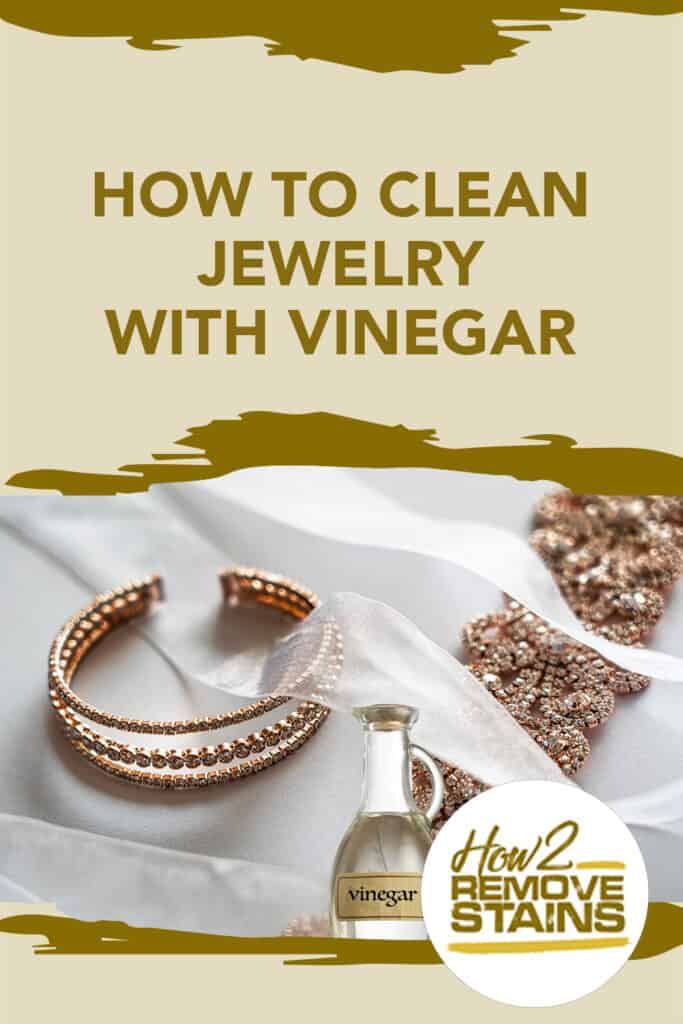Our precious jewelry tarnishes over time. That is due to exposure to the elements and things like lotion, deodorant, perfume, makeup, body oils, and our very own sweat! Luckily, a good amount of household distilled white vinegar does the trick to remove tarnish, either in a combative solution or working solo.
Vinegar contains acetic acid. Distilled white vinegar is preferable to food-based vinegar for cleaning jewelry. That is because the lab-created vinegar holds a higher pH level (of 2.4), unlike its fermented counterpart.
Vinegar’s acidity makes it a versatile liquid as a food additive and a disinfectant, among many other uses. One use is as a great cleaning agent, allowing it to break down grime and greasy build-up that oxidizes and tarnishes our jewelry.
Most household jewelry typically consists of brass (copper-composed), silver, and gold, among other precious metals. All these metals oxidize over time when exposed to the elements and bodily, applicants as previously mentioned.
Gold above 14 karats is an exception, though, as it rarely tarnishes. If so, it’s very little. Tarnishing causes jewelry to darken and look dull. Distilled white vinegar alone or coupled with baking powder, table salt, distilled water (if possible), and tea tree oil will do a great job in getting your jewelry sparkling again.
Table of Contents
What you will need to clean jewelry with vinegar
You will need the following:
- Distilled water
- Distilled white vinegar
- Table salt
- Baking soda
- A microfiber cloth or paper towels
- A shallow pan
- A clean container
- Aluminum foil
Note that distilled water is preferable to tap water. That is because distilled water gets treated to remove contaminants and minerals removed. Some minerals may react with jewelry, doing more harm. Using distilled water removes the potential damage.
Using distilled white vinegar alone
Distilled white vinegar is a versatile liquid with acetic acid that happens to be a great cleaning agent. Alone, it can get rid of light tarnishing on jewelry.
You will need the following:
- A cup of distilled white vinegar
- A liter of distilled water
Procedure:
- Wipe excess dirt and dust off jewelry to remove any impurities stuck. You can rinse with distilled water to ensure the jewelry is thoroughly clean.
- Pour distilled white vinegar in a shallow dish, enough to completely immerse the jewelry.
- Immerse the jewelry in the shallow dish, making sure it is submerged or covered with distilled white vinegar.
- Let it sit in the vinegar for three hours or more, depending on how tarnished the jewelry is.
- Afterward, remove the jewelry, rinse with distilled water, and dry. You can either use paper towels or a microfiber cloth to do so.
Using distilled white vinegar and baking soda
Distilled white vinegar coupled with baking soda makes a formidable tag-team cleaning force that dissolves organic compounds. Baking soda, unlike its vinegar partner, is on the other end of the pH scale. Combined, the two ingredients release carbon dioxide that helps lift dirt from jewelry for a deeper clean.
To use distilled white vinegar and baking powder, you will need the following:
- A cup of distilled white vinegar
- Four tablespoons of baking soda
- A liter of distilled water
Procedure:
- Having cleaned excess dirt and dust off jewelry, add a cup of distilled white vinegar in a clean container. Ensure the container is non-reactive as the chemical reaction can easily cause corrosion.
- Add four tablespoons of baking powder to the distilled white vinegar slowly to avoid an overflow due to the fizzing.
- Immerse the jewelry in the container making sure it is fully submerged.
- Let it sit in the solution for two to three hours at most.
- Afterward, remove the jewelry, rinse with distilled water, and dry with paper towels or a microfiber cloth.
Using distilled white vinegar, baking soda, and table salt
Distilled white vinegar and baking soda form a solid cleaning partnership. Adding salt to the fold further strengthens its effectiveness, as salt coupled with vinegar dissolves metallic oxides built up on jewelry. It makes for an intense clean in the event of heavy tarnish.
To use distilled white vinegar, baking powder, and table salt, you will need the following:
- A cup of distilled white vinegar
- A tablespoon of baking powder
- A tablespoon of table salt
- A cup of boiling water
Procedure:
- Coat the pan with aluminum foil face-up.
- In a container, mix the boiling water with baking powder and table salt evenly.
- After making sure the jewelry is clean from excess dirt and impurities, place them on the aluminum foil-coated pan. Spread out the jewelry to ensure all pieces are in contact with the foil.
- Add the baking powder and table salt mixture to the aluminum foil-coated pan and gradually add the distilled white vinegar. It should start to fizzle.
- Let the jewelry sit for ten to fifteen minutes. For a more effective clean, stir the jewelry evenly to mix well in the reaction.
- Afterward, remove the jewelry, rinse with distilled water, and dry with paper towels or a microfiber cloth.
Why should I use aluminum foil?
There is a science behind this. As mentioned, salt coupled with vinegar dissolves metallic oxides built upon jewelry. Jewelry, especially silver, is notorious for forming compounds with sulfur. The distilled white vinegar, baking powder, and table salt chemical reaction break down silver sulfide. Aluminum has a higher affinity for sulfur than silver does. Therefore, creating aluminum sulfide frees the sulfur from the silver.
Frequently Asked Questions
Is there another type of vinegar you can use in place of distilled white vinegar?
Yes, you can use food-based vinegar that gets made through a fermentation process, such as red wine vinegar. However, it may have poor acidic content, therefore, it’s not as effective as lab-created distilled white vinegar. Acidity is crucial as it helps break down grime and built-up oxides.
Are there metals sensitive to vinegar cleaning agents?
Yes, there are. Distilled white vinegar is acidic, and as much as it forms a great cleaning agent, prolonged periods on some metallic jewelry can easily cause corrosion. It is best to rinse thoroughly with distilled water after the use of vinegar-based cleaning agents. This will remove any traces of vinegar left that may react with the metal in the jewelry.
Take care of your jewelry
Regular cleaning of our precious jewelry is a good way to preserve family heirlooms, gifts from dear ones, or just great accessories. Vinegar helps to keep jewelry looking brand new by doing away with tarnish and grime that discolorize and dulls them. It’s safe to say, vinegar is a gift of cleaning science. However, if not properly handled, it can be villainous by causing corrosion.


